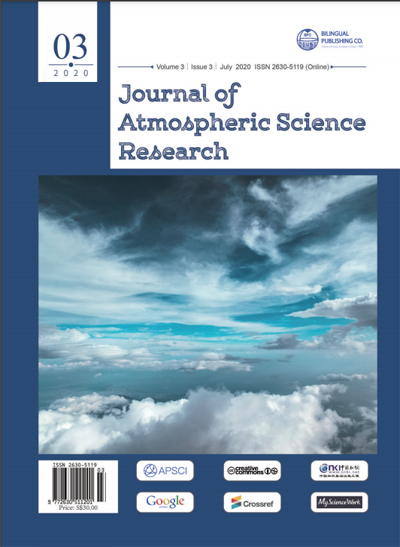-
2070
-
1489
-
1479
-
1351
-
1224
Absence of the Impact of the Flux of Cosmic Rays and the Cloud Cover on the Energy Balance of the Earth
DOI:
https://doi.org/10.30564/jasr.v3i3.2129Abstract
The energy of solar radiation absorbed by the Earth, as well as the thermal radiation of the Earth’s surface, which is released to the space through the atmospheric transparency window, depends on variations of the area of the cloud cover. Svensmark et al. suggest that the increase in the area of the cloud cover in the lower atmosphere, presumably caused by an increase in the flux of galactic cosmic rays during the quasi-bicentennial minimum of solar activity, results only in an increase in the fraction of the solar radiation reflected back to the space and weakens the flux of the solar radiation that reached the Earth surface. It is suggested, without any corresponding calculations of the variations of the average annual energy balance of the Earth Е, that the consequences will include only a deficit of the solar energy absorbed by the Earth and a cooling of the climate up to the onset of the Little Ice Age. These suggestions ignore simultaneous impact of the opposite aspects of the increase in the area of the cloud cover on the climate warming. The latter will result from a decrease in the power of thermal radiation of the Earth’s surface released to the space, and also in the power of the solar radiation reflected from the Earth’s surface, due to the increase in their absorption and reflection back to the surface. A substantial strengthening in the greenhouse effect and the narrowing of the atmospheric transparency window will also occur. Here, we estimate the impact of all aspects of possible long-term 2% growth of the cloud cover area in the lower atmosphere by Е. We found that an increase in the cloud cover area in the lower atmosphere will result simultaneously both in the decrease and in the increase in the temperature, which will virtually compensate each other, while the energy balance of the Earth E before and after the increase in the cloud cover area by 2% will stay essentially the same: E1 - E0 ≈ 0.
Keywords:
Climate, Cosmic rays, Cloud Cover, Energy Balance, Little Ice Age, Solar Irradiance, Greenhouse Effect, Atmospheric Transparency WindowReferences
[1] Shapiro, A. I., Schmutz, W., Rozanov, E., Schoell, M.,Haberreiter, M., Shapiro, A. V., Nyeki, S. E. A new approach to the long-term reconstruction of the solar irradiance leads to large historical solar forcing / Astron. Astrophys. 2011, 529: A67.
[2] Egorova, T., Schmutz, W., Rozanov, E., Shapiro, A. I.,Usoskin, I., Beer, J., Tagirov, R. V., Peter, T. Revised historical solar irradiance forcing / Astron. Astrophys. 2018, 615: A85.
[3] Abdussamatov, H. I. Lunnaya observatoriya dlya issledovanii klimata Zemli v epokhu glubokogo pokholodaniya (Lunar Observatory for Earth climate studies in the deep Ice Age) St. Petersburg: Nauka, 2017: 128. (In Russian)
[4] Abdussamatov, H. I. Current long-term negative average annual energy balance of the Earth leads to the new Little Ice Age // Thermal Sci. 2015. Vol. 19, pp. S279-S288.
[5] Abdussamatov, H. I. The new Little Ice Age has started. Evidence-Based Climate Science. Easterbrook D. J. (ed) Oxford: Elsevier, 2016, pp. 307-328.
[6] Abdussamatov, H. I. Comparative analysis of errors in monitoring the Earth’s global energy budget by the Lunar Observatory and orbiters // Izv., Atmos. Ocean. Phys., 2018, Vol. 54, no. 9, pp. 1341–1352.
[7] Trenberth, K. E., Fasullo, J. T., and Kiehl, J. Earth’s global energy budget // Bull. Am. Meteorol. Soc., 2009, Vol. 90, pp. 311–323. https://doi.org/10.1175/2008BAMS2634.1
[8] Abdussamatov, H. I. The Earth’s climate does not depend on variations in cosmic rays and cloud coverage // Geomagnetism and Aeronomy. 2019. 59, 935–941.
[9] Svensmark, H., Friis-Christensen, E. Variation of cosmic ray flux and global cloud coverage – a missing link in solar–climate relationships // J. Atmos. Sol.-Terr. Phys. 1997. Vol. 59, pp. 1225–1232. https://doi.org/10.1016/S1364-6826(97)00001-1.
[10] Svensmark, H. Cosmoclimatology: A new theory emerges // Astron. Geophys. 2007. Vol. 48, pp. 1.18–1.24. https://doi.org/10.1111/j.1468-4004.2007.48118.x.
[11] Svensmark, H., Enghoff, M. B., Shaviv, N. J., Svensmark, J. Increased ionization supports growth of aerosols into cloud condensation nuclei // Nat. Commun. 2017. Vol. 8, pp. 2199, https://doi.org/10.1038/s41467-017-02082-2.
[12] Stozhkov, Y. I., Bazilevskaya, G. A., Makhmutov, V. S., Svirzhevsky, N. S., Svirzhevskaya, A. K., Logachev, V. I., Okhlopkov V. P. Cosmic rays, solar activity, and changes in the Earth’s climate // Bull. Russ. Acad. Sci.: Phys. 2017. Vol. 81, pp. 252–254.
[13] Nils-Axel, M. The approaching new Grand solar minimum and Little Ice Age climate conditions // Nat. Sci. 2015. Vol. 7, pp. 510–518.
[14] Sloan, T. and Wofendale, A. W. Testing the proposed causal link between cosmic rays and cloud cover // Environ. Res. Lett., 2008, Vol. 3, no. 2, pp. 024001. https://doi.org/10.1088/1748-9326/3/2/024001
[15] Sloan, T. and Wofendale, A. W. The contribution of cosmic rays to global warming // J. Atmos. Sol.-Terr. Phys., 2011, Vol. 73, no. 16, pp. 2352–2355. https://doi.org/10.1016/j.jastp.2011.07.013
[16] Erlykin, A. D., Sloan, T., and Wofendale, A. W. A review of the relevance of the ‘CLOUD’ results and other recent observations to the possible effect of cosmic rays on the terrestrial climate // Meteorol. Atmos. Phys., 2013, Vol. 121, nos. 3–4, pp. 137–143. https://doi.org/10.1007/s00703-013-0260-x
[17] Abdussamatov, H. I. Cosmic rays and clouds variations effect on the climate is insignificantly // Applied Physics Research. 2018. Vol. 10, pp. 81-86.
[18] Milankovitch, M. Kanon der erdbestrahlungen und seine anwendung auf das eiszeitenproblem. In: Canon of insolation and the Ice Age problem. With Introduction and biographical essay by Nikola Pantic. Hardbound Alven Global Belgrade, 1998. 636 pp (in English).
[19] Odyssey studies changing weather and climate on Mars. The changing south polar cap of Mars: 1999–2005, MGS MOC Release. 2005, no. MOC2-1151.
[20] Ravilious, K. Mars melt hints at solar, not human, cause for warming, scientist says. National Geographic News. 2016. May 6.




 H. I. Abdussamatov
H. I. Abdussamatov





